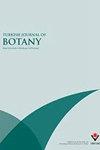草莓果实发育过程中植物化学物质的评价及氧化应激途径的作用(Fragaria×ananassa)
IF 1.5
4区 生物学
Q3 PLANT SCIENCES
引用次数: 0
摘要
草莓(Fragaria × ananassa)是蔷薇科的一种,被认为是经济和营养重要的浆果水果。植物化学物质是形成果实等特征的关键成分。香味和风味。本研究对草莓果实在绿、白、红三个发育阶段的植物化学特性进行了研究。HPLC测定结果表明,红果中的葡萄糖、果糖和蔗糖浓度显著增加,而成熟果实中葡萄糖被确定为主要糖(2.8 g- 1fw)。对苯丙氨酸途径的评价表明,随着苯丙氨酸解氨酶活性的增加,总酚和类黄酮的含量在果实发育过程中下降。与酚类化合物不同,维生素C在红色阶段显著增加,而抗氧化能力在果实发育的所有阶段几乎不变。果实成熟期各抗氧化酶活性均高于青果期。在后期,超氧化物歧化酶活性最高。红果中碳水化合物的增加是由于这些化合物在水果成熟过程中调节代谢途径的作用。酚类化合物含量的降低和抗氧化能力的稳定表明非酚类抗氧化化合物如维生素C在成熟和保持抗氧化性能中的作用。通过对草莓成熟过程中植物化学物质和抗氧化能力的鉴定,揭示了各种化合物和氧化应激通路信号在果实成熟过程中的作用;这也有助于草莓在果实发育的不同阶段广泛应用于食用和非食用工业。本文章由计算机程序翻译,如有差异,请以英文原文为准。
Evaluation of phytochemicals and the role of oxidative stress pathways during fruit development in strawberries (Fragaria×ananassa)
Strawberries (Fragaria × ananassa) are one of the Rosaceae family, considered economically and nutritionally important berry fruits. Phytochemicals are crucial ingredients that contribute to characteristics such as the fruit?s aroma and flavor. The current study investigated the phytochemical characteristics of strawberry fruit at three developmental stages (green, white, and red). HPLC measurements determined the glucose, fructose, and sucrose concentrations significantly increased in the red fruit, whereas glucose was identified as the major sugar in ripe fruit (2.8 g.g-1FW). Evaluation of the phenylpropanoid pathway implied that the amount of total phenol and flavonoid following phenylalanine ammonia-lyase enzyme activity decreased during fruit development. Unlike phenolic compounds, vitamin C was considerably increased in the red stage, while antioxidant capacity was almost constant in all stages of fruit development. The activities of all antioxidant enzymes at the ripe fruit stage were higher than in the green fruit. At the final stage, the superoxide dismutase enzyme had the highest activity. Increasing carbohydrates in the red fruit is due to the role of these compounds in regulating metabolic pathways during fruit ripening. The reduction of phenolic contents and the stability of antioxidant capacity indicates the role of nonphenolic antioxidant compounds such as vitamin C in the ripening and preservation of antioxidant properties. Identifying the phytochemicals and antioxidant capacity of strawberries during ripening reveals the role of various compounds and oxidative stress pathway signaling in fruit ripening; it can also contribute to the widespread application of strawberries in the edible and nonedible industries at different stages of fruit development.
求助全文
通过发布文献求助,成功后即可免费获取论文全文。
去求助
来源期刊

Turkish Journal of Botany
PLANT SCIENCES-
CiteScore
2.90
自引率
5.60%
发文量
31
审稿时长
6-12 weeks
期刊介绍:
The Turkish Journal of Botany is published electronically 6 times a year by the Scientific and Technological Research Council of Turkey (TÜBİTAK) and accepts manuscripts (in English) covering all areas of plant biology (including genetics, evolution, systematics, structure, function, development, diversity, conservation biology, biogeography, paleobotany, ontogeny, functional morphology, ecology, reproductive biology, and pollination biology), all levels of organisation (molecular to ecosystem), and all plant groups and allied organisms (algae, fungi, and lichens). Authors are required to frame their research questions and discuss their results in terms of major questions in plant biology. In general, papers that are too narrowly focused, purely descriptive, or broad surveys, or that contain only preliminary data or natural history, will not be considered (*).
The following types of article will be considered:
1. Research articles: Original research in various fields of botany will be evaluated as research articles.
2. Research notes: These include articles such as preliminary notes on a study or manuscripts on the morphological, anatomical, cytological, physiological, biochemical, and other properties of plant, algae, lichen and fungi species.
3. Reviews: Reviews of recent developments, improvements, discoveries, and ideas in various fields of botany.
4. Letters to the editor: These include opinions, comments relating to the publishing policy of the Turkish Journal of Botany, news, and suggestions. Letters should not exceed one journal page.
(*) 1. Raw floristic lists (of algae, lichens, fungi, or plants), species descriptions, chorological studies, and plant sociology studies without any additional independent approaches.
2. Comparative morphology and anatomy studies (that do not cover a family, tribe, subtribe, genus, subgenus, section, subsection, or species complexes with taxonomical problems) without one or more independent additional approaches such as phylogenetical, micromorphological, chromosomal and anatomical analyses.
3. Revisions of family, tribe, genus, subgenus, section, subsection, or species complexes without any original outputs such as taxonomical status changes, IUCN categories, and phenological and ecological analyses.
4. New taxa of all plants without any additional independent approaches such as phylogenetical, ecological, chromosomal, chorological and correlational analyses in addition to a detailed macro- and micro-morphological descriptions with quality field and microscopic illustrations of taxonomically important structures and identification key in the taxonomic group.
New records of all plants without any additional independent approaches such as phylogenetical, ecological, chromosomal, chorological and correlational analyses in addition to a detailed macro- and micro-morphological descriptions with quality field and microscopic illustrations of taxonomically important structures and identification key in the taxonomic group may be accepted for peer review if they contain 3 or more new records or taxonomical status update, such as lectotypification, new combinations, transfers, revivals and synonyms.
5. New taxa of algae, lichens, and fungi without any additional independent approaches such as phylogenetical, ecological, chromosomal, chorological and correlational analyses in addition to a detailed macro- and micro-morphological descriptions with quality field and microscopic illustrations of taxonomically important structures and identification key in the taxonomic group.
New records of algae, lichens, and fungi without any additional independent approaches such as phylogenetical, ecological, chromosomal, chorological and correlational analyses in addition to a detailed macro- and micro-morphological descriptions with quality field and microscopic illustrations of taxonomically important structures and identification key in the taxonomic group may be accepted for peer review if they contain 5 or more new records or taxonomical status update, such as lectotypification, new combinations, transfers, revivals and synonyms.
 求助内容:
求助内容: 应助结果提醒方式:
应助结果提醒方式:


